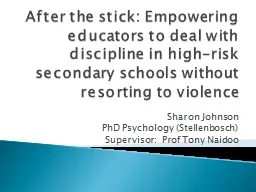

Sharon Johnson PhD Psychology Stellenbosch Supervisor Prof Tony Naidoo What progress in education since democracy School to university to job system is failing SA society We are suffering from emotional and social illiteracy where emotions triumph over logic reason replaced ID: 498446
Download Presentation The PPT/PDF document "After the stick: Empowering educators to..." is the property of its rightful owner. Permission is granted to download and print the materials on this web site for personal, non-commercial use only, and to display it on your personal computer provided you do not modify the materials and that you retain all copyright notices contained in the materials. By downloading content from our website, you accept the terms of this agreement.
Slide1
After the stick: Empowering educators to deal with discipline in high-risk secondary schools without resorting to violence
Sharon Johnson
PhD Psychology (Stellenbosch)
Supervisor
: Prof Tony NaidooSlide2
What progress in education since democracy? School to university to job system is failing SA society. We are suffering from “emotional and social illiteracy” where emotions triumph over logic, reason replaced by wrath and where books take second place to rocks (Jansen, 2012).No short cuts to changing society – we need to place education at the centre for change, confronting the rot in the school system.
Social revolutionSlide3
Learner killed in gang crossfireWeapons brought to schoolTeacher glued to his chairFire started at schoolBomb scares disrupted classesTeacher throttled a child in a fit of rage
13 year old learner accidentally shot dead by his father
Pupil pulled a gun on headmaster and teacher
Teaching contextSlide4
“I am not so negative about my work because you have a role to play. Learners have become very aggressive, you know they question you, they don’t take very well to authority, especially the Grade 8’s – it’s a difficult stage where they are at…In the past I did have a stick, but this year I have not used the stick; just once. If you hit a child there are repercussions, so I don’t want to go there.
I try to use my voice when I can and I think that is where the burnout comes in a lot of the time…what it is doing to me physically.”
Teacher commentSlide5
SA teaching profession in a crisis Severe shortages of teachersHigh absenteeism and resignationHigh levels of stress related diseases such as high blood pressure and diabetes
Crisis in the professionSlide6
Social and physical pain produce similar brain responses for distressAll threat will be interpreted and magnified by learners SCARF (Rock, 2009) :status; certainty; autonomy; relatedness and fairnessThree brain model – physical response first, emotional response and finally rational response
Brain responses to threatSlide7
Schools
Interventions
Qualitative methods
Quantitative methods
School 1: TRE -
17 educators
School 2: TP - 16 educatorsSchool 3: TA - 10 educatorsSchool 4: Control - 20 educators Trauma Release Exercises (TRE) Transpersonal Psychology (TP)Transactional Analysis (TA) Focus group: thematic analysis Statistical analysis: Perceived Stress ScaleBurnout: Personal, Work and Client (Learner); Well-being Coding analysis: Workshop assessment questionnaire and appreciative inquiry reflections on stressors
Research Design - Overview
of Mixed-Methods Research Methodology
Slide8
63 took part – 20 in a control group; the rest in three high schools on the Cape FlatsBoth sexes equally represented: 32 men; 31 womenMost were married (76%); most were Christian (65%); Most were aged between 40 and 50 years.
65% reported themselves to be burnout
Burnout is emotional exhaustion, depersonalisation and lack of personal accomplishment with unmet needs.
Demographic details of educatorsSlide9
Physical response: Trauma Release Exercises (Berceli, 2007) – neurogenic tremorsEmotional response: Transpersonal Psychology in Capacitar workshops (Cane, 2000) – heart coherence
Rational response: Transactional Analysis (Berne, 1961) – social psychology
Intervention designSlide10
Statistical analysis revealed that stress and learner burnout reduction were significant in the TRE and TA interventions, pre- to post tests, with TP showing a trend of reduction. Multiple benefits on a physical, emotional and rational level for all interventions.Classroom competence improved, with educators taking responsibility for discipline
Violence was no longer considered an option in any of the classrooms after the interventions.
FindingsSlide11
Violent behaviour between educator and learners in the gangland schools of the Cape Flats was positively affected by teachers attending psycho-educational workshops over a relatively short period of time (10 weeks, 15 hours in total), with simple insights and techniques which can be taught relatively easily. Whether these are physical, emotional or rational ways of working with educators, all are effective and can be combined for optimal effect.
ConclusionSlide12
For further information please contact:Sharon Johnson: shajohnson@mweb.co.za072 2644140
References:
Berceli
, D. (2007).
Evaluating the effects of stress reduction exercises
. Unpublished doctoral dissertation, Arizona State University
Berne, E. (1961).
Transactional analysis in psychotherapy
. New York: Grove Press.
Cane, P. M. (2000).
Trauma healing and transformation.
California:
Capacitar int.Jansen, J. (2012, January 7). Matric razzmatazz conceals sad reality. Weekend Argus, p.4. Johnson, S.M. (2013). Impact of stress and burnout interventions on educators in igh-risk secondary schools. Doctoral dissertation, University of StellenboschScaer, R.C. (2007). The body bears the burden: Trauma, dissociation and disease (2nd ed.). New York: Norton. Thank you